Introduction
Homemade Ice Cream Recipe is one of the most satisfying desserts you can make in your own kitchen. Nothing beats the taste of fresh, creamy ice cream made from high-quality ingredients. Whether it’s a hot summer day or a cozy dessert night, making ice cream at home allows you to control the flavors, sweetness, and texture — something store-bought options simply can’t match.
Last summer, a family decided to make ice cream together for the first time. Using a simple homemade recipe, they created creamy vanilla ice cream with chunks of chocolate and fresh strawberries. The kids loved adding their favorite toppings, and the result was a fun, delicious, and fully customizable treat. That experience shows why a homemade ice cream recipe is perfect for family bonding and experimenting with flavors.
In this comprehensive guide, you’ll learn step-by-step instructions for classic ice cream, easy no-churn recipes, and even vegan options. We’ll cover essential ingredients, tips for perfect texture, common mistakes to avoid, and creative flavor ideas. You’ll also find storage advice, serving suggestions, and troubleshooting tips to ensure every batch turns out smooth, creamy, and delicious.
Whether you’re a beginner or an experienced home chef, this homemade ice cream recipe guide will give you all the tools and tips you need to create ice cream that rivals your favorite ice cream shop. By the end of this article, you’ll be confident in making endless flavor combinations and impressing your friends and family with a perfect frozen treat every time.
Why Make Ice Cream at Home?
Making homemade ice cream offers numerous advantages over store-bought alternatives. From better freshness to healthier options and complete creative control, making your own ice cream is a fun and rewarding experience. This guide will highlight the key benefits and reasons why you should consider making ice cream at home.
1. Freshness and Ingredient Control
When you make homemade ice cream, one of the biggest advantages is the freshness and ingredient control. Unlike store-bought varieties that often contain preservatives, artificial flavors, and chemicals, homemade ice cream is free from these additives. By making ice cream at home, you get to choose the highest quality ingredients, ensuring a cleaner, healthier treat.
Key Benefits of Freshness and Control:
- No preservatives or artificial additives
- Full control over ingredient quality
- Fresher taste with every scoop
Homemade ice cream allows you to enjoy the unadulterated flavors of fresh ingredients, providing a premium taste that’s far superior to the mass-produced alternatives.
2. Healthier Options for You and Your Family
A key reason for making homemade ice cream is the ability to create healthier options tailored to your dietary preferences. When you make ice cream at home, you control the amount of sugar, fat, and other ingredients.
Health Benefits:
- Use lower-fat options (e.g., Greek yogurt, almond milk)
- Create dairy-free, vegan, or gluten-free alternatives
- Use natural sweeteners like honey or agave instead of refined sugar
Whether you’re looking to reduce your sugar intake, avoid dairy, or try other dietary preferences, homemade ice cream offers a way to indulge in a sweet treat without compromising your health goals.
3. Endless Creative Possibilities
One of the most exciting parts of making ice cream at home is the ability to customize it to your exact tastes. You can create unique and innovative flavors that are not available in stores.
Customize Your Flavors:
- Traditional options: vanilla, chocolate, strawberry
- Unique flavors: mango-coconut, salted caramel, pistachio
- Add-ins: chocolate chips, cookie dough, nuts, fruit chunks
Homemade ice cream lets you experiment with flavor combinations that suit your preferences. From the base flavor to the toppings, you are the creator. This customization is impossible to replicate with store-bought versions, making homemade ice cream a far more enjoyable and unique dessert.
4. A Fun Family Activity
Making ice cream at home isn’t just about eating the treat—it’s about the experience. Homemade ice cream is a fun, interactive activity for the whole family. Kids especially love getting involved in selecting flavors, adding mix-ins, and watching the transformation as the mixture freezes.
Why It’s Great for Families:
- Engaging activity for all ages
- Educational experience: Learn about ingredient selection and the freezing process
- Perfect for family bonding and special occasions
Making homemade ice cream together is not only fun but also helps teach kids about food preparation, science, and cooking skills.
Essential Ingredients and Tools for Homemade Ice Cream
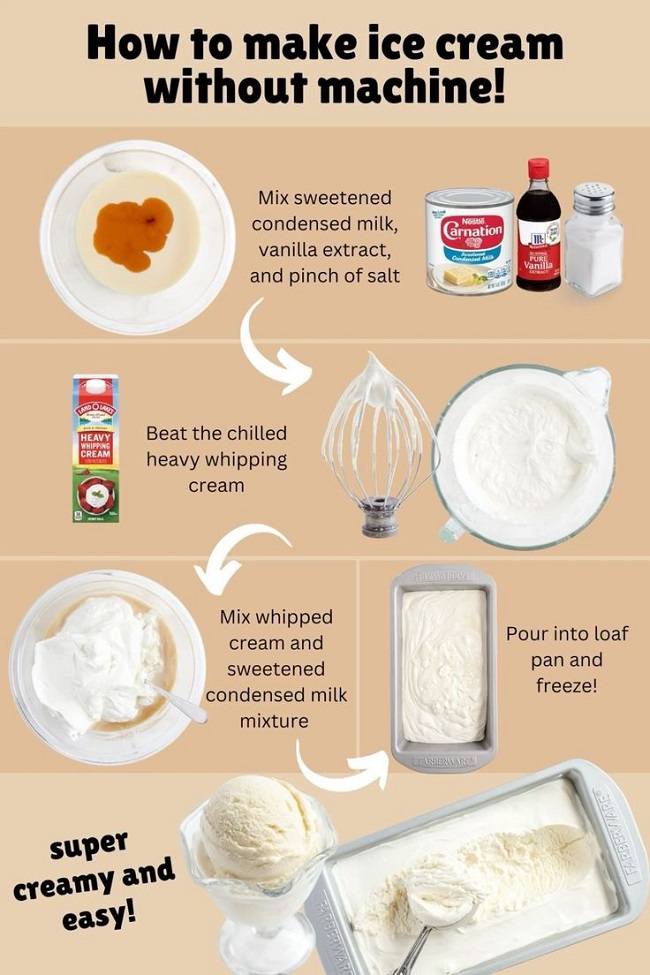
Making homemade ice cream is a delightful and rewarding experience, but to achieve the perfect creamy, smooth texture, you need the right ingredients and tools. Whether you’re new to making ice cream or a seasoned pro, understanding the core components and tools will ensure your homemade ice cream recipe yields delicious results every time. Here’s everything you need to know about the essential ingredients and tools for making your own ice cream.
Core Ingredients for Homemade Ice Cream
To create a classic homemade ice cream recipe, you’ll need a few key ingredients that provide the base for all your ice cream creations. These core ingredients are responsible for the smooth texture and rich flavor you expect from homemade ice cream.
- Cream and Milk: The base of every homemade ice cream recipe consists of a combination of heavy cream and whole milk. These ingredients provide the essential creamy texture that homemade ice cream is known for. For the richest flavor, opt for high-fat cream and milk.
- Sugar: Sugar adds the sweetness and helps to achieve the desired consistency. It also prevents the formation of large ice crystals, which ensures that your ice cream has a smooth texture.
- Eggs: Although optional, eggs are used in custard-style ice creams to enhance richness and contribute to the creamy texture. If you prefer a lighter, eggless version, you can skip them, but they do make a significant difference in flavor and texture.
- Vanilla: Vanilla extract is a must-have for most ice cream recipes. It adds a subtle sweetness and enhances the flavor profile of your homemade ice cream. Always choose pure vanilla extract for the best taste.
- Flavorings: Customize your ice cream with various flavorings like chocolate, coffee, mint, or fruit extracts. The possibilities are endless when it comes to homemade ice cream flavor options. You can mix in ingredients like cocoa powder, fresh fruit, or even herbs to personalize your creation.
Optional Ingredients for Extra Flavor and Texture
Once you’ve mastered the basic homemade ice cream recipe, you can elevate it by adding optional ingredients to create unique flavors and textures.
- Chocolate: Add chocolate chips, chunks, or melted chocolate to your ice cream base for extra richness and flavor.
- Fruits: Fresh fruit or fruit purees, such as strawberries, blueberries, or mango, provide a fresh twist to your ice cream. Fruit swirls or chunks will enhance both the flavor and texture.
- Nuts: Chopped nuts, such as pistachios, almonds, or walnuts, can add a delightful crunch and richness to your homemade ice cream.
- Sauces and Mix-ins: Swirl in caramel, chocolate fudge, or fruit sauces for a decadent touch. These can also add complexity and layers of flavor to your ice cream.
Essential Tools for Making Homemade Ice Cream
The right tools are essential for crafting the best homemade ice cream. These tools will make your ice cream-making process smoother and help you achieve the ideal texture and consistency.
- Ice Cream Maker: An ice cream maker is crucial for churning the mixture as it freezes. This tool helps prevent large ice crystals from forming, ensuring that your ice cream is smooth and creamy. While a hand-churned method is possible, an ice cream maker makes the process quicker and more efficient.
- Mixing Bowls and Spatulas: You’ll need mixing bowls to combine your ingredients and spatulas to scrape down the sides of the bowls, ensuring everything is well-mixed and smooth.
- Freezer Containers: After churning, your ice cream needs to be transferred to freezer-safe containers. Glass or plastic containers with airtight lids are ideal for storing your homemade ice cream to prevent freezer burn and maintain the best flavor and texture.
Tips for Best Results
To get the best results from your homemade ice cream recipe, follow these expert tips:
- Use high-quality ingredients: The quality of your cream, milk, and flavorings directly affects the taste of your ice cream. Opt for fresh, organic, and premium products to elevate your recipe.
- Chill your base before churning: Allow your ice cream base to chill completely in the refrigerator for a few hours before churning. This ensures a smoother texture and prevents over-churning.
- Don’t overfill your ice cream maker: Leave some space in the ice cream maker to allow for the mixture to expand as it freezes. Overfilling can lead to uneven freezing and texture issues.
- Storage tips: To keep your ice cream creamy, store it in airtight containers, and allow it to freeze for at least 4 hours before serving to ensure it hardens properly.
Classic Homemade Ice Cream Recipe
Making a classic homemade ice cream recipe from scratch is a rewarding process that results in rich, creamy, and delicious ice cream. Whether you choose the vanilla custard method or the cooked method, you’ll enjoy a smooth and flavorful treat. Follow these step-by-step instructions to create the perfect ice cream, and use our tips to troubleshoot any issues for the best results. This guide will help you achieve a silky texture and balanced flavor in every batch of your homemade ice cream recipe.
Vanilla Custard Method for Classic Homemade Ice Cream
The vanilla custard method involves cooking eggs to create a creamy base. This method is ideal for those who want a rich, traditional ice cream texture. Here’s how to make a classic homemade ice cream recipe using the vanilla custard method.
Ingredients:
- 2 cups heavy cream
- 1 cup whole milk
- 3/4 cup granulated sugar
- 5 large egg yolks
- 1 tablespoon pure vanilla extract
- Pinch of salt
Instructions:
- Prepare the Ice Cream Base: In a medium saucepan, combine the heavy cream and whole milk. Heat over medium heat until the mixture begins to steam, but don’t let it boil.
- Whisk the Egg Yolks: While the cream mixture is heating, whisk the egg yolks and sugar together in a separate bowl until the mixture is pale and smooth.
- Temper the Eggs: Slowly pour a small amount of the hot cream mixture into the egg yolk mixture while whisking constantly. This step helps prevent the eggs from curdling. Gradually add the rest of the cream mixture into the egg yolks, continuing to whisk.
- Cook the Custard: Return the combined mixture to the saucepan and cook over medium heat, stirring constantly with a wooden spoon or spatula. Cook until the custard thickens and coats the back of the spoon, which usually takes about 5-7 minutes. Be careful not to overheat or boil the mixture, as this could scramble the eggs.
- Strain and Cool: Once the custard has thickened, strain it through a fine mesh sieve into a clean bowl to remove any coagulated egg bits. Stir in the vanilla extract and a pinch of salt.
- Chill the Custard: Let the custard cool at room temperature for about 30 minutes, then refrigerate for at least 4 hours or overnight. This step ensures that the custard is completely chilled before churning.
- Churn: Once chilled, pour the custard into your ice cream maker and churn according to the manufacturer’s instructions. This usually takes about 20-30 minutes.
- Freeze: Transfer the churned ice cream into an airtight container and freeze for at least 4 hours or until firm.
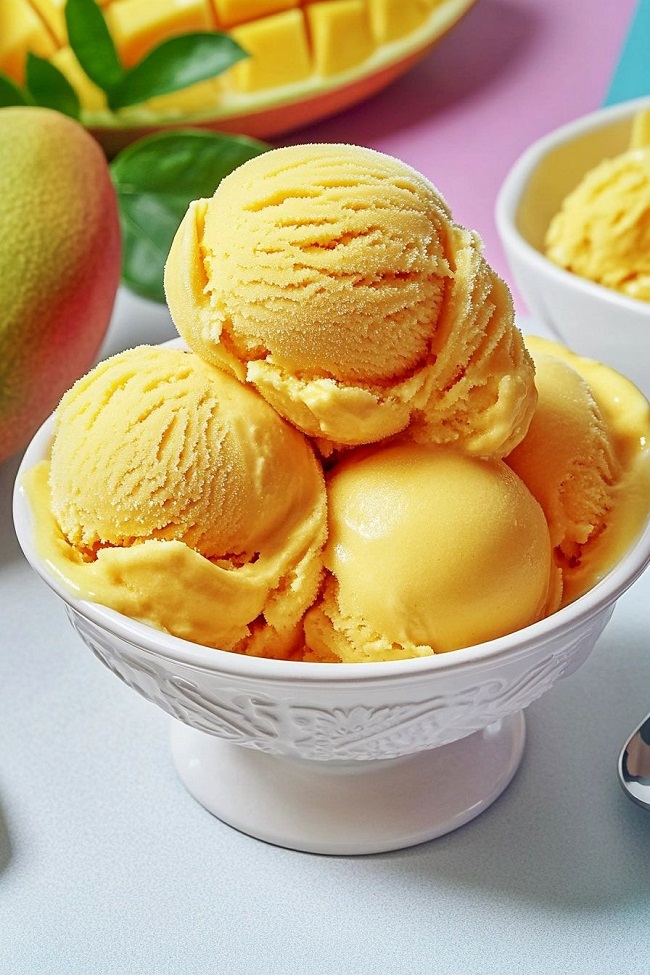
Cooked Method for Classic Homemade Ice Cream
The cooked method uses a similar process to the custard method but without the egg yolks, resulting in a lighter and quicker version of the classic homemade ice cream recipe. Here’s how you can make it:
Ingredients:
- 2 cups heavy cream
- 1 cup whole milk
- 3/4 cup granulated sugar
- 1 tablespoon pure vanilla extract
- Pinch of salt
Instructions:
- Combine Ingredients: In a medium saucepan, mix the heavy cream, whole milk, sugar, and salt. Heat over medium heat, stirring occasionally until the sugar is dissolved and the mixture is hot (but not boiling).
- Cool the Mixture: Remove the saucepan from the heat and stir in the vanilla extract. Let the mixture cool to room temperature.
- Chill: Once the mixture is cooled, refrigerate it for at least 4 hours or overnight to ensure it is completely chilled.
- Churn: Pour the chilled mixture into your ice cream maker and churn according to the manufacturer’s instructions.
- Freeze: Transfer the churned ice cream to an airtight container and freeze for at least 4 hours before serving.
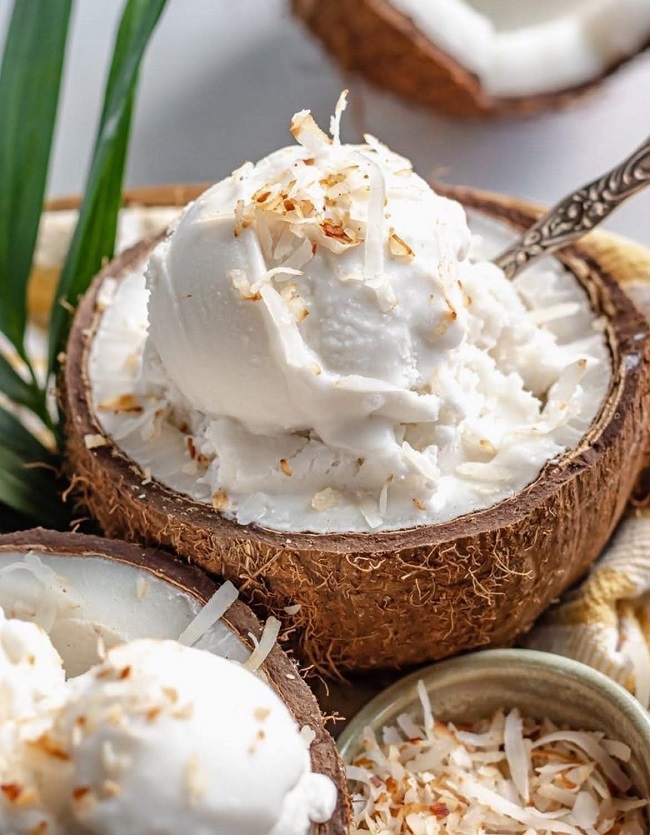
Tips for Achieving a Smooth, Creamy Texture
To ensure your classic homemade ice cream recipe has a smooth and creamy texture, follow these expert tips:
- Chill your mixture thoroughly: The colder the mixture is before churning, the smoother your ice cream will be. Always chill your ice cream base for at least 4 hours or overnight.
- Use an ice cream maker: An ice cream maker is the key to preventing large ice crystals and achieving a smooth, velvety texture.
- Add alcohol (optional): A small amount of alcohol, such as vodka or rum, can prevent your ice cream from freezing too hard, making it easier to scoop.
Troubleshooting Tips
Even when following a classic homemade ice cream recipe, problems can arise. Here’s how to troubleshoot common issues:
1. Avoiding Ice Crystals:
- Problem: Ice crystals form, resulting in a grainy texture.
- Solution: Ensure that your mixture is well-chilled before churning, and use an ice cream maker to churn it properly. If you’re making the ice cream without an ice cream maker, stir it every 30 minutes while freezing to break up any ice crystals.
2. Over-Churning:
- Problem: Ice cream turns into butter-like texture.
- Solution: Stop churning when the ice cream reaches a soft-serve consistency. Over-churning causes the fat in the cream to separate, leading to a butter-like texture.
3. Flavor Balance:
- Problem: The flavor is too bland or overly sweet.
- Solution: Taste the mixture before churning and adjust the sweetness by adding more sugar or a pinch of salt if needed. A pinch of salt helps balance the sweetness and enhances the overall flavor.
No-Churn Ice Cream Recipes
If you’re craving a homemade ice cream recipe but don’t have an ice cream maker, no worries! Making easy homemade ice cream recipe without a machine is simpler than you might think. No-churn ice cream recipes are incredibly convenient and produce delicious, creamy results with minimal effort. This guide will walk you through step-by-step instructions for making no-churn ice cream at home, along with some fun flavor variations and texture tips.
How to Make No-Churn Ice Cream
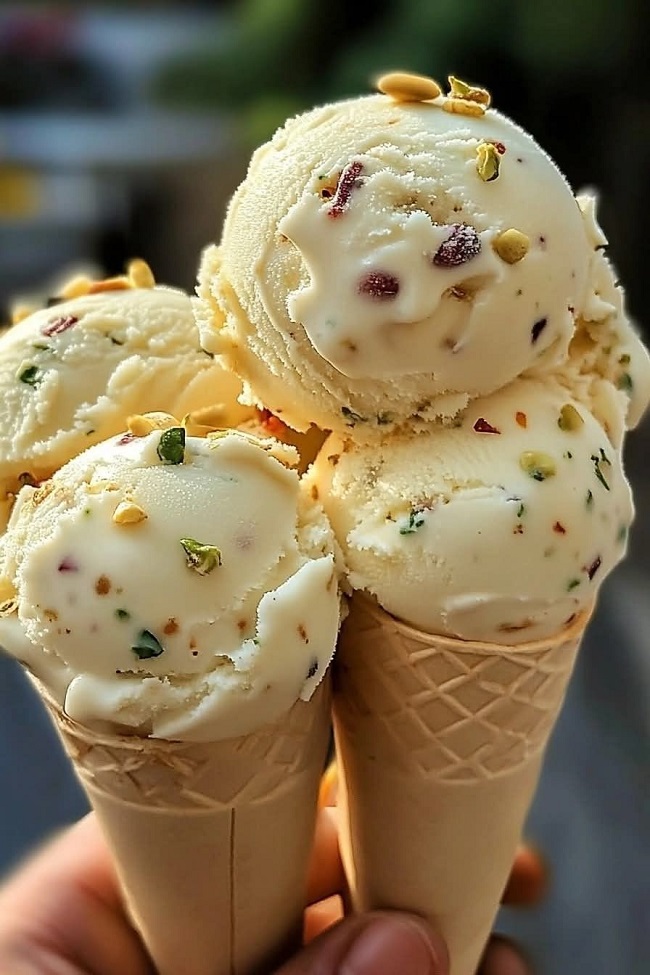
Making a homemade ice cream recipe without a machine is as simple as mixing a few key ingredients and freezing them. Here’s a basic recipe to get you started:
Ingredients:
- 2 cups heavy whipping cream
- 1 can (14 oz) sweetened condensed milk
- 1 teaspoon vanilla extract
- Pinch of salt
Instructions:
- Whip the Cream: In a large mixing bowl, whip the heavy whipping cream using an electric mixer or stand mixer. Whip it until stiff peaks form. This step is crucial for achieving a smooth, airy texture in your easy homemade ice cream recipe.
- Combine the Ingredients: In another bowl, mix the sweetened condensed milk, vanilla extract, and a pinch of salt. Stir to combine until smooth.
- Fold the Mixtures Together: Gently fold the whipped cream into the condensed milk mixture. Use a spatula and mix carefully to preserve the airiness of the whipped cream. The goal is to have a smooth, uniform mixture without deflating the whipped cream.
- Freeze: Transfer the mixture into an airtight container and spread it out evenly. Cover and freeze for at least 4 hours or overnight for the best results. The ice cream will firm up in the freezer and be ready to enjoy!
Flavor Variations for No-Churn Ice Cream
One of the best things about this easy homemade ice cream recipe is how easily it can be customized. Try these fun and delicious flavor variations to make your no-churn ice cream even more exciting.
1. Chocolate No-Churn Ice Cream
- Ingredients:
- 1/4 cup unsweetened cocoa powder
- 1/2 cup chocolate chips (optional)
2. Strawberry No-Churn Ice Cream
- Ingredients:
- 1/2 cup strawberry puree (fresh or frozen strawberries blended)
- 1/4 cup chopped strawberries (optional)
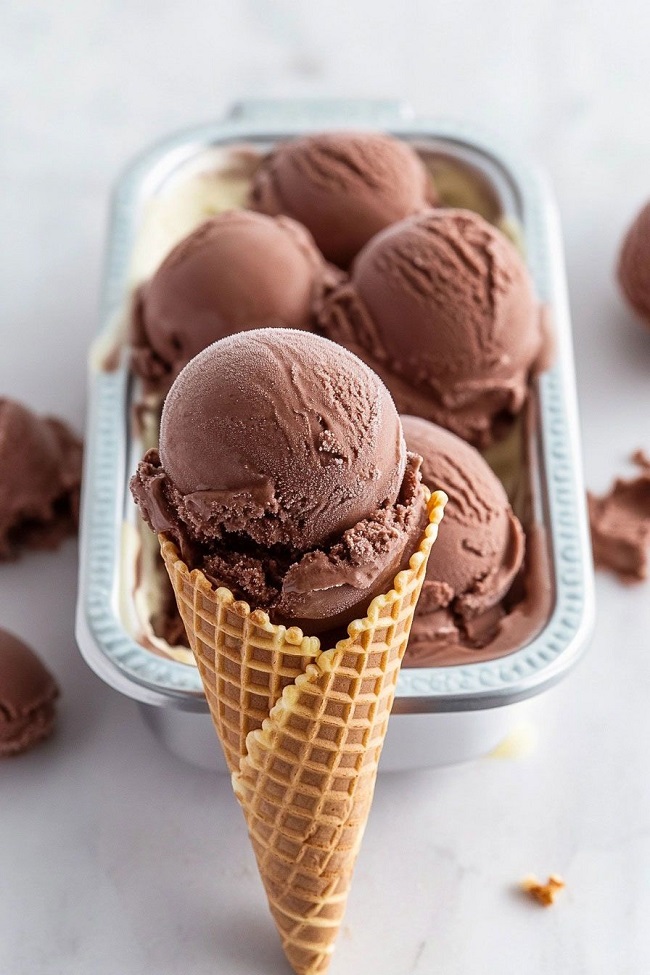
3. Cookies & Cream No-Churn Ice Cream
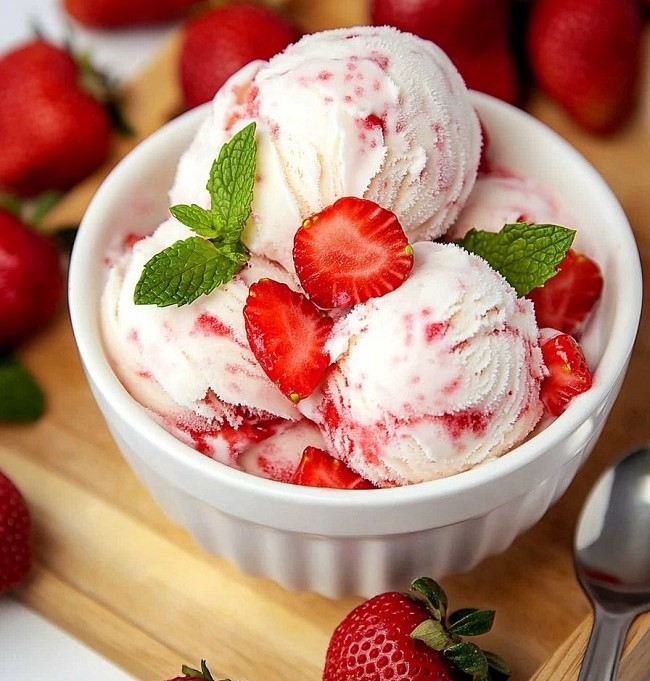
- Ingredients:
- 12 crushed Oreo cookies (or your favorite sandwich cookie)
Soft Serve vs Firm Texture Tips
The texture of your homemade ice cream recipe can vary depending on how you freeze it. Here’s how you can adjust the texture to your liking:
Soft Serve:
- Tip: For a softer, more scoopable texture, freeze your ice cream for a shorter amount of time (about 4 hours). Once you take it out of the freezer, let it sit for a few minutes to soften slightly before scooping.
- Result: This texture is perfect if you prefer your ice cream with a light and creamy consistency, similar to soft serve.
Firm Texture:
- Tip: If you prefer a firmer texture, let your ice cream freeze for 6-8 hours or overnight. To achieve a more traditional, scoopable consistency, you may need to let the ice cream sit at room temperature for a few minutes before serving.
- Result: This method results in a more solid, traditional ice cream texture, similar to what you get from store-bought brands.
Why This No-Churn Ice Cream Recipe Is So Popular
This easy homemade ice cream recipe is perfect for anyone who wants to enjoy delicious, creamy ice cream without the hassle of using an ice cream maker. It’s a quick and convenient way to indulge in homemade ice cream that doesn’t require special equipment or complicated techniques.
The versatility of this homemade ice cream recipe is another reason it’s a fan favorite. You can mix and match different flavorings, toppings, and add-ins to create a personalized dessert that suits your taste preferences. Whether you love chocolate, fruit, or classic cookies & cream, there’s a no-churn ice cream flavor for everyone.
Popular Flavor Variations & Mix-Ins for Homemade Ice Cream
Making your own homemade ice cream recipe gives you the ultimate freedom to experiment with endless flavors and mix-ins. Whether you prefer creamy classics like chocolate and vanilla or seasonal delights like pumpkin spice and mango, customizing your easy homemade ice cream recipe is a fun and rewarding experience. In this guide, we’ll explore popular ice cream flavors, exciting mix-ins, and helpful tips for creating the perfect texture in your homemade frozen treats.
Classic Flavor Variations
1. Chocolate Ice Cream
Chocolate ice cream is a universally loved flavor. For a rich, deep chocolate taste, you can use melted dark chocolate or cocoa powder. Both options will give your homemade ice cream recipe a deliciously smooth and velvety texture.
- Tip: Add chocolate chips or chunks during the final mixing to boost the chocolatey experience and add a satisfying crunch.
2. Caramel Ice Cream
Caramel ice cream offers a perfect blend of sweetness and creaminess. Add store-bought or homemade caramel sauce to your base, or swirl the sauce into your ice cream for a marbled effect. For extra depth of flavor, try a salted caramel version.
- Tip: Add a pinch of sea salt to your caramel for a salted caramel twist. This simple addition elevates the flavor and creates a perfect balance between sweet and savory.
3. Fruit-Based Ice Cream
Fruit-flavored ice cream is a refreshing alternative to traditional options. Strawberry, raspberry, and blueberry are popular fruit flavors. Simply puree fresh or frozen fruit and blend it into your homemade ice cream recipe for a fresh, vibrant twist.
- Tip: For added texture, fold in chopped fruit pieces or freeze-dried fruit for an intense fruit flavor without added moisture.
4. Nut-Flavored Ice Cream
Nuts like pistachios, almonds, and hazelnuts add a delightful crunch and nutty flavor to ice cream. You can either grind the nuts into a smooth paste or chop them for a more textured, crunchy ice cream.
- Tip: Toast your nuts before adding them to your ice cream base. Toasting enhances the nutty flavor and adds depth to the final result.
5. Coffee Ice Cream
Coffee ice cream offers a sophisticated flavor profile that’s perfect for coffee lovers. Use brewed coffee or instant espresso powder to infuse the base with a rich coffee taste.
- Tip: Add chocolate chips or swirl in some chocolate fudge sauce for a mocha-inspired homemade ice cream recipe.
6. Cookie Dough Ice Cream
Cookie dough ice cream is a fan favorite thanks to its indulgent, doughy chunks mixed into creamy ice cream. Make edible cookie dough without eggs for a safe and delicious addition to your easy homemade ice cream recipe.
- Tip: Freeze the cookie dough chunks before adding them to prevent them from melting during churning.
Seasonal Flavor Variations
1. Pumpkin Spice Ice Cream
Perfect for fall, pumpkin spice ice cream combines warm spices like cinnamon, nutmeg, and cloves with the creamy richness of ice cream. This seasonal flavor pairs beautifully with caramel or pecans for added texture.
- Tip: Add a dash of ground ginger for extra warmth and a bold flavor in your homemade ice cream recipe.
2. Mango Ice Cream
Mango ice cream is a tropical delight, combining the sweet and tangy flavor of mango with a creamy base. This flavor is light and refreshing, perfect for summer days.
- Tip: Enhance the tropical feel by adding coconut flakes or a splash of lime juice to your easy homemade ice cream recipe.
3. Berry Swirl Ice Cream
Berry swirl ice cream is perfect for spring and summer. You can use strawberries, raspberries, blackberries, or blueberries to create a refreshing, fruity ice cream.
- Tip: Swirl the berry puree into your ice cream to create a beautiful marbled effect. Add lemon zest to enhance the berry flavor for a tangy twist.
Tips for Adding Chunks, Swirls, and Sauces
Adding mix-ins like chunks, swirls, and sauces can turn your homemade ice cream recipe into a more exciting and flavorful dessert. Here are some tips for incorporating these elements seamlessly:
1. Chunks
To add chunks of cookies, candy, or fruit, make sure they are small enough to distribute evenly throughout your ice cream. Freeze your chunks before adding them to the mixture to prevent them from melting into the base during the churning process.
2. Swirls
Swirling sauces such as caramel, chocolate, or fruit puree into your ice cream adds both texture and flavor. For a beautiful swirl effect, drizzle the sauce into the ice cream as it churns, then fold it in gently to maintain the swirl without overmixing.
- Tip: Don’t overmix the swirls; you want to preserve the contrast between the ice cream and the swirled sauce for an eye-catching look.
3. Sauces
Adding sauces like chocolate, fudge, or peanut butter to your homemade ice cream recipe can create delicious ribbons of flavor throughout. Drizzle the sauce over the ice cream before freezing, or swirl it in during the last few minutes of churning.
- Tip: Let the ice cream chill for about 30 minutes before adding the sauce to allow it to firm up slightly, helping the sauce to remain distinct in the mixture.
Why Customize Your Homemade Ice Cream?
Creating a homemade ice cream recipe allows you to tailor the flavor profile to your preferences. Whether you love chocolate, fruit, or a more exotic combination like pumpkin spice or mango, homemade ice cream lets you experiment and create something uniquely yours. Plus, you have control over the ingredients, so you can ensure the quality and freshness of every scoop.
Vegan & Dairy-Free Options for Homemade Ice Cream
Looking for a homemade ice cream recipe that is both vegan and dairy-free? You’re in the right place! With the right non-dairy milk and alternative sweeteners, you can create a creamy, delicious ice cream without the need for dairy. Whether you prefer coconut milk, almond milk, or soy milk, there’s a plant-based option for everyone. This guide will show you how to make a rich, indulgent easy homemade ice cream recipe that’s both dairy-free and vegan-friendly.
Best Non-Dairy Milk Options for Homemade Ice Cream
The key to making a homemade ice cream recipe that’s both vegan and creamy lies in the base. Non-dairy milks are the foundation of vegan ice cream, and choosing the right one can make all the difference in achieving that perfect, smooth texture.
1. Coconut Milk
Coconut milk is one of the most popular choices for dairy-free ice cream recipes because of its high fat content, which provides a rich, creamy texture. The natural sweetness of coconut milk enhances the flavor and makes it ideal for tropical flavors like mango, pineapple, or coconut itself.
- Tip: Use full-fat coconut milk for the creamiest texture. Mixing in coconut cream will also help create an even richer, velvety ice cream base.
2. Almond Milk
Almond milk is another great option for vegan ice cream, offering a light yet creamy texture. It has a neutral flavor, allowing other ingredients like vanilla, fruit, or chocolate to shine. Almond milk is ideal for those who prefer a less intense coconut flavor in their ice cream.
- Tip: For a thicker texture, opt for unsweetened almond milk or add a spoonful of almond butter to your homemade ice cream recipe.
3. Soy Milk
Soy milk is one of the thickest and most versatile non-dairy milks, making it an excellent choice for homemade ice cream recipes. With its naturally creamy consistency, it adds structure to the ice cream, ensuring a rich texture without using any dairy.
- Tip: Look for unsweetened soy milk for better control over the sweetness of your easy homemade ice cream recipe.
Alternative Sweeteners for Dairy-Free Ice Cream
Traditional ice cream recipes often use refined sugar, but in vegan homemade ice cream recipes, you can substitute it with healthier, natural sweeteners. Here are a few great options:
1. Maple Syrup
Maple syrup is a fantastic natural sweetener that works perfectly in dairy-free ice cream recipes. It adds a delicious caramel-like flavor and pairs well with vanilla, chocolate, and nut-based ice creams. Plus, it’s minimally processed, making it a healthier alternative to refined sugar.
2. Agave Syrup
Agave syrup is a vegan-friendly sweetener derived from the agave plant. It has a mild, neutral flavor, making it an excellent option for sweetening easy homemade ice cream recipes without overpowering the other flavors.
- Tip: Agave syrup is sweeter than sugar, so you can use less of it in your homemade ice cream recipe for the perfect level of sweetness.
3. Coconut Sugar
Coconut sugar is made from the sap of the coconut palm and has a natural caramel flavor. It’s a great option for adding a rich, subtle sweetness to your homemade ice cream recipe while providing some additional nutrients compared to white sugar.
- Tip: Use coconut sugar sparingly, as its flavor can be more intense than refined sugar. It’s perfect for ice creams like chocolate or coffee.
Maintaining Creaminess Without Dairy
One of the biggest challenges in making a homemade ice cream recipe without dairy is achieving the same creamy texture that traditional ice cream provides. Here are some tips for keeping your vegan ice cream just as smooth and indulgent:
- Use Full-Fat Plant-Based Milk: Full-fat coconut milk, soy milk, or almond milk provide the fat necessary to mimic the creamy texture of dairy ice cream. Full-fat options are key to a rich, smooth result.
- Add Coconut Cream: For extra creaminess, consider adding coconut cream to your ice cream base. It’s thicker and richer than regular coconut milk, enhancing the texture and flavor.
- Incorporate Starches or Gums: To prevent your ice cream from becoming icy or grainy, you can add small amounts of cornstarch or guar gum to the base. These ingredients help thicken the mixture and provide the creamy consistency you desire.
- Churn Properly: Using an ice cream maker is ideal for ensuring a smooth, creamy texture. Churning prevents ice crystals from forming and helps incorporate air into the ice cream, resulting in a fluffier, lighter consistency.
Storage, Serving & Presentation Tips for Homemade Ice Cream
Once you’ve made your homemade ice cream recipe, it’s essential to store, serve, and present it properly to maintain its creamy texture and flavor. Whether you’re storing it for later or preparing a beautiful presentation for your guests, following the right homemade ice cream serving tips will ensure you get the most out of your homemade treat. Let’s dive into the best practices for freezing, serving, and presenting your homemade ice cream recipe.
Freezing Tips & Container Recommendations
Proper storage is crucial for preserving the flavor and texture of your homemade ice cream recipe. Here are some helpful tips for freezing your ice cream the right way:
1. Choose the Right Storage Containers
Airtight containers are the key to keeping your homemade ice cream recipe fresh and smooth. Glass or high-quality plastic containers with tight-fitting lids are ideal. By storing the ice cream in airtight containers, you’ll prevent ice crystals from forming and maintain the creamy texture.
- Tip: Before sealing the container, place a layer of plastic wrap directly on the surface of the ice cream to prevent air exposure.
2. Freezer Temperature
For the best results, keep your freezer at a consistent temperature of 0°F (-18°C). This ensures that the ice cream stays firm but still easy to scoop. If you have a deep freezer, it’s perfect for storing ice cream over the long term, as it maintains a more stable temperature than a regular freezer.
3. Shelf Life of Homemade Ice Cream
When stored properly, homemade ice cream can last up to 2-3 weeks in the freezer. Beyond this, the texture may become too hard, and the flavor might start to degrade. For the best taste and consistency, consume it within this time frame.
Perfect Scoops and Presentation Ideas
The presentation of your homemade ice cream recipe can make it even more enjoyable. Here are some homemade ice cream serving tips to ensure your ice cream is as visually appealing as it is delicious.
1. Warm the Scoop for Smooth, Perfect Scoops
To make perfect scoops every time, dip your ice cream scoop in warm water before scooping. This will help the ice cream slide off the scoop easily and create smooth, round scoops that look great in any serving dish.
2. Serving in Cones vs. Bowls
Choosing between a cone or a bowl depends on the style and experience you want to create for your guests:
- Cones: Waffle or sugar cones are classic and fun for casual servings. They add a delightful crunch and enhance the overall texture of your homemade ice cream recipe.
- Bowls: Serving your ice cream in a bowl provides a more elegant experience, allowing you to add toppings like whipped cream, fruit, and chocolate sauce. A chilled bowl will keep the ice cream colder for longer.
3. Sundae Creations
To elevate your homemade ice cream recipe, turn it into a sundae. Start with a scoop of ice cream, and layer it with your favorite toppings such as hot fudge, caramel sauce, crushed nuts, maraschino cherries, and whipped cream. Add extra fun elements like crumbled cookies or candy pieces for texture.
- Tip: Drizzle sauces like chocolate, caramel, or fruit syrups in a decorative pattern to make your sundae visually striking.
4. Garnishing Ideas
For a polished and elegant look, garnish your homemade ice cream recipe with fresh fruit, mint leaves, or even edible flowers. These small touches make a big difference in the visual appeal of your presentation.
- Tip: A sprinkle of chopped nuts or shaved chocolate on top of a scoop adds a delightful texture contrast while making your ice cream look more refined.
Troubleshooting Common Mistakes in Homemade Ice Cream
Creating a homemade ice cream recipe can be a fun and rewarding process, but sometimes issues arise. Whether you’re dealing with ice crystals, overly soft or hard ice cream, or flavor imbalances, don’t worry—these problems are common and can be easily fixed. This guide will help you troubleshoot some of the most common mistakes and provide quick fixes and preventative tips to help you perfect your homemade ice cream recipe every time.
1. Ice Crystals in Homemade Ice Cream
Problem:
Ice crystals can form in your homemade ice cream recipe, leading to a grainy texture instead of the smooth, creamy consistency you desire.
Quick Fix:
If you notice ice crystals, the main cause is usually under-chilling the base or improper churning. Ensure your ice cream mixture is fully chilled before placing it in the ice cream maker, and churn it until it reaches a thick, soft-serve consistency.
Preventative Tip:
To prevent ice crystals from forming, always use an ice cream maker for churning. This helps break up ice crystals and evenly distributes the mixture as it freezes, ensuring a smooth texture in your homemade ice cream recipe.
2. Too Soft or Too Hard Ice Cream
Problem:
Your homemade ice cream recipe may end up too soft and melty, or too hard to scoop.
Quick Fix:
If your ice cream is too soft, simply allow it to freeze for several more hours or overnight. If it’s too hard, let it sit at room temperature for 5–10 minutes to soften for easier scooping.
Preventative Tip:
For the right texture, set your freezer to 0°F (-18°C). Ensure the ice cream base has chilled for at least 4 hours before churning. Also, don’t overchurn the mixture—once it reaches soft-serve consistency, stop churning to avoid freezing it too hard.
3. Overmixing or Undermixing the Ice Cream Base
Problem:
Overmixing your ice cream can lead to a buttery texture, while undermixing can result in uneven flavor or poor texture.
Quick Fix:
Avoid overmixing by stopping the churning process once the mixture achieves a smooth, soft-serve texture. To prevent under-mixing, make sure the base is thoroughly combined before churning.
Preventative Tip:
Stick to the homemade ice cream recipe instructions carefully, and be mindful of the churning time. Over-churning can turn the mixture into butter, while undermixing can result in a poor flavor distribution.
4. Flavor Imbalance
Problem:
Your homemade ice cream recipe might be too sweet, too bland, or have a flavor that is not well balanced.
Quick Fix:
Taste the mixture before churning and adjust the sweetness level. Add more vanilla extract, fruit, or a pinch of salt to balance out the flavor. If your ice cream is too sweet, a small amount of salt can help balance the flavors.
Preventative Tip:
Always use fresh, high-quality ingredients in your homemade ice cream recipe. Taste-test your base before churning and adjust the flavors accordingly to ensure the final product is perfectly balanced.
Conclusion
Homemade Ice Cream Recipe proves that making ice cream at home is easier, more versatile, healthier, and far more rewarding than buying store-bought options. With simple ingredients and a little creativity, anyone can craft creamy, flavorful ice cream tailored to personal tastes. From classic vanilla to decadent chocolate or fruity sorbets, the possibilities are endless when you take control of the recipe yourself.
By trying a homemade ice cream recipe, you can experiment with flavors, mix-ins, and textures that suit your preferences. Adding fresh fruits, chocolate chips, nuts, or swirls of caramel allows you to customize every batch and create unique frozen treats your family and friends will love. This hands-on approach not only makes dessert fun but also helps you make healthier choices by controlling sugar, cream, and dairy content.
Ultimately, a homemade ice cream recipe is about creativity, enjoyment, and satisfaction. Whether you use a no-churn method or a traditional ice cream maker, you’ll notice the difference in taste, texture, and freshness compared to store-bought alternatives. Taking the time to experiment with ingredients and techniques elevates every batch into a memorable treat.
Try this homemade ice cream recipe today and discover how fun and rewarding it is to create your own ice cream masterpieces. Don’t forget to share your favorite homemade ice cream recipe in the comments to inspire other readers and join a community of ice cream enthusiasts. Embrace your creativity and make every scoop a delicious experience!
FAQs,
Can I make ice cream without an ice cream maker?
Yes! You can enjoy a delicious homemade ice cream recipe without any special equipment. The no-churn method is perfect for beginners—simply whip heavy cream with sweetened condensed milk, fold in your favorite flavors or mix-ins, and freeze. This approach delivers creamy, smooth ice cream that rivals store-bought versions, showing the real benefits of homemade ice cream.
How long does homemade ice cream last?
A properly stored homemade ice cream recipe can last 2–4 weeks in the freezer. Always use an airtight container to prevent ice crystals from forming. Unlike store-bought ice cream, homemade versions don’t contain preservatives, so enjoying it fresh maximizes both flavor and texture.
Can I use alternative sweeteners?
Absolutely! You can make a homemade ice cream recipe using natural sweeteners like honey, maple syrup, agave, or stevia. Adjust sweetness carefully, as these alternatives can slightly change texture. Using alternative sweeteners is a great way to enjoy ice cream while keeping it healthier, highlighting one of the key benefits of homemade ice cream.
How do I make low-fat or vegan ice cream?
You can transform any homemade ice cream recipe into a low-fat or vegan-friendly treat by using plant-based milks such as coconut, almond, or oat milk. Pair with fruits, nuts, or dairy-free chocolate to create creamy, indulgent ice cream that fits any dietary preference. This flexibility sets homemade ice cream apart from store-bought options.
Why is my ice cream icy instead of creamy?
An icy texture usually occurs when the mixture isn’t chilled enough, lacks sufficient fat, or isn’t stirred regularly. Following a trusted homemade ice cream recipe, using the right balance of cream and milk, and occasionally stirring during freezing helps achieve a perfectly smooth, creamy result every time.






